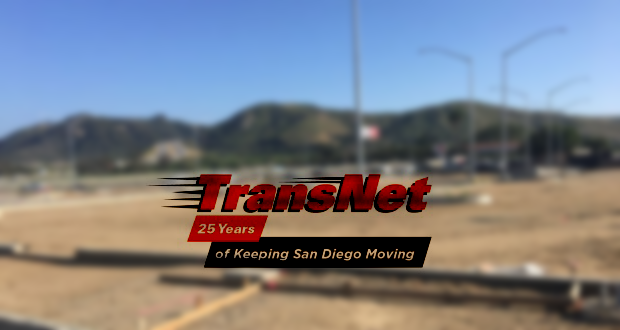SANDAG Has Completed or Is Underway On More Than 60 Percent of Program Projects
San Diego County CA— A performance review of the San Diego Association of Governments TransNet Extension program shows that the agency has built, is in construction on, or has started on the planning of more than 60 percent of the projects in the first ten years, or one-quarter of the 40-year life of the half-cent sales tax for transportation.
According to the comprehensive Ten-Year Review, 33 percent of the projects have been completed and 28 percent are either in construction or moving forward with the planning, environmental review, and design process.
The report, compiled by the performance review firm Sjoberg Evashenk Consulting, Inc., found that SANDAG “delivered on its plans and expanded freeways, improved local roads, added capacity to rail and Trolley service, added new Rapid service and increased transit services for seniors.”
The report concluded that the region’s transportation systems “generally outperformed its peers” in comparison areas such as hours of delay, operating expenses, and transit farebox recovery.
“We are pleased that the independent review has found that substantial progress has been made,” said SANDAG Chair and Del Mar City Councilmember Terry Sinnott. “Our focus has always been on execution of the TransNet program in order to fulfill our promise to the voters and our regional partners.”
The review found that it is reasonable to conclude that SANDAG will be able to complete all the projects included in the TransNet Extension Ordinance (approved countywide by voters in 2004) within the timeframe based on historical performance going back to the beginning of the TransNet program.
The review included information about funds expected to be collected over the 40-year life of the TransNet Extension program – which ends in 2048. No new revenue forecasts were made for the report. It included previously reported SANDAG projections that the agency will collect about $9 billion. SANDAG projects that it will collect between $9 billion and $11 billion in 2002 dollars.
The original forecast for the TransNet Extension projected that the agency would collect $14 billion. Nevertheless, the review found that it is reasonable to expect that SANDAG will be able to complete all the projects in the program, largely because construction costs dropped dramatically during the Great Recession and SANDAG was able to advance projects and complete them with less funds.
The report also found that SANDAG through the TransNet program has:
- Dedicated approximately $344 million for transit services improvements with ridership rising to nearly 105 million from 94.5 million a decade ago.
- Invested $220 million in mitigation and habitat conservation, acquiring 8,900 acres of land for environmental mitigation at a savings of $120 million due to low-cost land prices.
- Dedicated more than $714 million for the Local Street and Road Program in local municipalities, completing more than 136 projects.
- Approved $200 million for bikeways improvement, that will add 77 miles of bike paths by 2023.
- Invested more than $2.9 billion in highway improvements, completing 23 segments and adding 90 miles of highway lanes, either managed or general purpose.
- Upgraded more than 80 transit stations – bus and trolley – and purchased 94 new vehicles, 65 of which were low-floor trolley vehicles.
- Provided more than $75 million in grants for senior transportation options, Smart Growth initiatives, and Active Transportation.
The report also stated that the agency should vigilantly monitor new technology and other transportation innovations to take advantage of future opportunities.
The report had several recommendations for the Board of Directors to consider for the next decade of the program, based on the current report and the future results of a separate triennial that will be completed this year by the TransNet Independent Taxpayer Oversite Committee. The recommendations include:
- Reevaluate projects in the portfolio against emerging intelligent transportation systems across multiple networks. Consider more projects like the SANDAG Integrated Corridor Management System, piloted since 2013 along a 20-mile corridor of Interstate 15 in Escondido, Poway, and San Diego.
- Evaluate projects against the growing focus on environment and sustainable communities.
- Invest in intelligent traffic system technology to manage multimodal efforts considering the emphasis on sustainable community and complete street efforts.
- Allocate funding for tracking, analysis, and reporting to enhance performance data to report more fully on the taxpayer’s return on investment and to comply with recently-passed federal and state legislation.
- Require added performance reporting from local jurisdictions receiving TransNet funds in the Local Streets and Roads Program, which affects 30 percent of the TransNet funding, and revisit congestion relief requirements in this category.
- Revisit the local environmental mitigation bank, which has a $187 million balance with only $12.5 million having been spent.
The TransNet Extension Ordinance requires that the SANDAG Board of Directors, acting as the San Diego County Regional Transportation Commission, conduct a comprehensive review of all projects and programs in the implementation plan every ten years.
This is the first step in the Ten-Year Review. The second step will look ahead and consider revisions to the expenditures, the implementation plan, and other provisions to improve performance of the TransNet program. This look forward will take place concurrent with the update over the next two years of San Diego Forward: The Regional Plan, SANDAG’s big picture vision for the region’s future (largely focused on transportation infrastructure).
The Board of Directors received the report on Friday during its regularly scheduled meeting. For the full report see item 11 in Friday’s agenda



